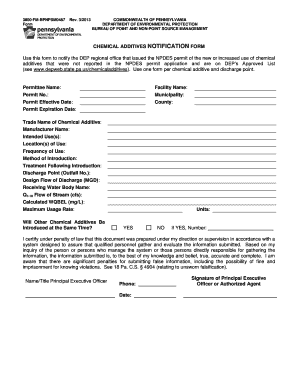
Get Chemical Additives Notification Form.pdf - Dep Document Repository - Elibrary Dep State Pa
How it works
-
Open form follow the instructions
-
Easily sign the form with your finger
-
Send filled & signed form or save
How to fill out the Chemical Additives Notification Form.pdf - DEP Document Repository - Elibrary Dep State Pa online
This guide provides step-by-step instructions for completing the Chemical Additives Notification Form, essential for notifying the Pennsylvania Department of Environmental Protection of any new or increased use of chemical additives. Following these instructions will ensure you submit the form accurately and in compliance with applicable regulations.
Follow the steps to successfully complete the form online.
- Press the ‘Get Form’ button to access the Chemical Additives Notification Form. This action allows you to download and view the form.
- Begin by entering the permittee name, the facility name, the permit number, permit effective date, and the permit expiration date. This information ensures that the notification is linked to the correct permit.
- Input the municipality and county where the facility is located. This helps identify the jurisdiction of the DEP regional office responsible for your notification.
- In the provided field, list the trade name of the chemical additive as it appears on the DEP’s Approved List. Ensure accuracy to avoid processing delays.
- State the name of the manufacturer of the chemical additive. This information is crucial for identifying the source of the chemical.
- Clearly describe the intended use(s) of the chemical additive at the facility. Specific details assist the DEP in understanding its application.
- List all locations within the facility where the chemical will be introduced. Precise identification of use sites helps in regulatory assessments.
- Report the frequency of use, specifying how often the chemical will be introduced into process waters (e.g., daily or monthly).
- Explain the method of introduction, indicating whether it is automatic or manual, and detail the procedure of delivery into the wastewater stream.
- Identify any treatment processes that will occur after the introduction of the chemical, which may help reduce concentrations before discharge.
- Provide the discharge point number as defined in the permit for tracking the location of wastewater discharge.
- Report the design flow of discharge in million gallons per day (MGD), using historical data if necessary.
- Specify the receiving water body name where the outfall discharges. This is important for environmental impact assessments.
- Identify the Q7-10 flow of the stream, using reports from the latest NPDES permit fact sheet or estimates derived from credible sources.
- Calculate the governing water quality-based effluent limit (WQBEL) and attach any necessary documentation or calculations.
- Indicate the maximum usage rate of the chemical additive, providing units such as pounds per day or gallons per day.
- Check the appropriate box if other chemical additives will be introduced simultaneously, noting their quantity if applicable.
- Finally, ensure the form is signed and dated by the principal executive officer or an authorized agent to validate the document.
- Save the completed form once all fields are filled. You can then download, print, or share the form as needed.
Complete your Chemical Additives Notification Form online today to ensure compliance and maintain your operations smoothly.
Different types of food additives antioxidants – these stop food becoming rancid or changing colour by reducing the chance of fats combining with oxygen. colours. emulsifiers, stabilisers, gelling agents and thickeners – these help to mix or thicken ingredients. preservatives – used to keep food safer for longer.
Industry-leading security and compliance
-
In businnes since 199725+ years providing professional legal documents.
-
Accredited businessGuarantees that a business meets BBB accreditation standards in the US and Canada.
-
Secured by BraintreeValidated Level 1 PCI DSS compliant payment gateway that accepts most major credit and debit card brands from across the globe.


